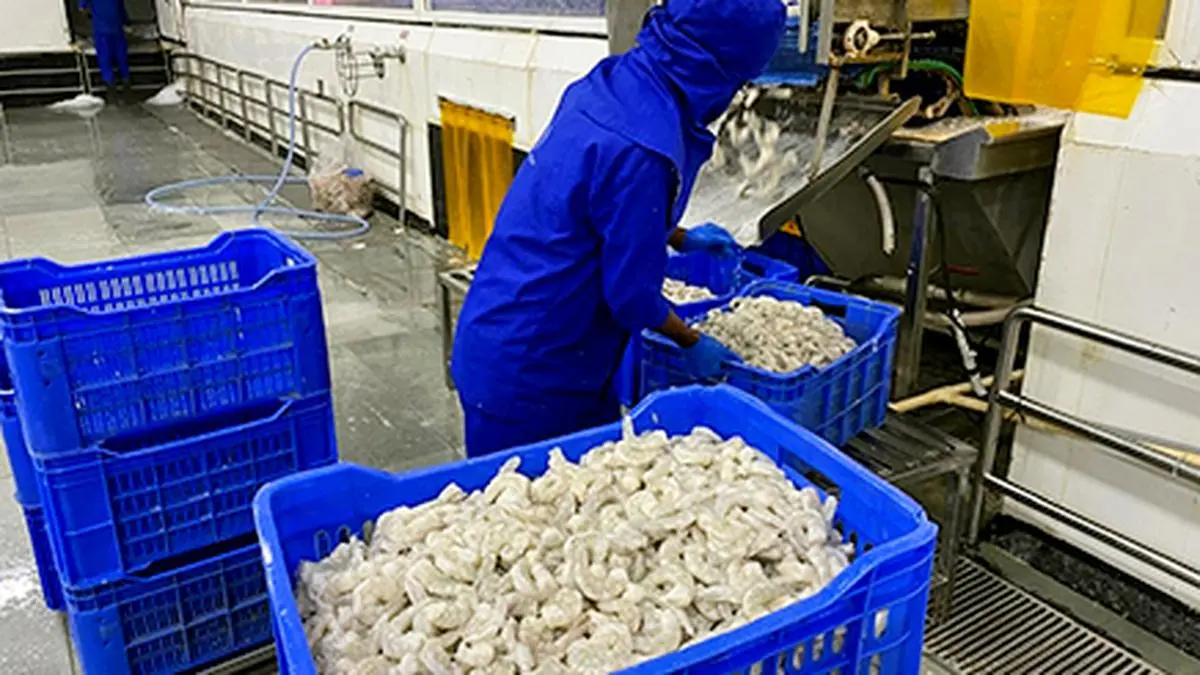
Processed fish and seafood market in India is expected to reach $21.04 billion, says industry expert
| Photo Credit:
The Hindu
Amidst the uncertainty triggered by Trump’s tariffs and countervailing duties in their largest export market, the Indian shrimp producers are formulating a “look inward” strategy to tap the burgeoning domestic market.
India’s domestic market for shrimps has untapped potential, supported by rising disposable income, growing health consciousness and a large population. While isolated efforts have been made in the past, there has been no structured and focused campaign to fully explore and develop this market.
“We are remodelling our business by targeting 50 per cent of the domestic market by introducing ready-to-cook and ready-to-eat shrimp products,” said Shaji Baby John, Chairman and Managing Director, Kings Infra, one of the large players.
Setting up cold chains
Quoting reports, John said the processed fish and seafood market in India is expected to reach $21.04 billion, out of which the organised sector of the domestic market is only 3-5 per cent. The market is projected to grow at a CAGR of 8.55 per cent in the next five years.
He stressed the need for setting up cold chain facilities, last-mile connectivity, and a distribution network to keep the quality and freshness of seafood. The Union government is extending adequate financial support to strengthen the distribution network in the domestic market. But the majority of these funds are getting exhausted due to lack of awareness.
IPR Mohan Raju, President of Prawn Farmers Federation of India, said a sustainable domestic market requires a dedicated supply chain network distinct from the current fragmented system where quality, consistency in supply and pricing remain major challenges.
Viable, scalable route
The federation has proposed the creation of farmer organisations to anchor this shift with initiatives to establish a reliable cold chain and logistics network; promotion of value-added and frozen shrimp formats for retail markets, ensuring quality assurance mechanisms at the farm-gate level. This must be jointly supported by the Centre through the Ministry of Fisheries, in coordination with state governments, he said, adding that ensuring supply, quality and price stability in the domestic market would reduce the over-dependence on volatile export destinations.
Frozen shrimp is the most viable and scalable route for distributing shrimp in the domestic market while maintaining hygiene and quality. However, the five per cent GST on frozen and branded seafood products makes it more expensive. “We request the Ministry to recommend to the GST Council that frozen seafood be zero-rated, at least for a defined period, to support domestic market growth”, Mohan Raju said.
Basically, shrimps are not a preferred item in many North Indian cities compared to poultry meat despite its high nutritional value. Punjab is the only exception for jumbo prawns. Moreover, Indian domestic markets do not entertain frozen shrimps and prefer only fresh ones. However, the supply chain constraints are hindering the availability of fresh seafood varieties from coastal states to North Indian markets, said a veteran seafood exporter in Kochi.
There is a need for a proper campaign in the domestic market to popularise the protein value of shrimps like that of eggs. This would perk up consumption, he said.
Waking up now
Arpan Bhalerao, Chief Growth Officer, Aquaconnect Global, said about 40 per cent of Indian shrimp production is currently exported to the US, making it vulnerable to tariff-related disruptions. In the short term, these additional costs will have to be absorbed across the value chain. “However, we believe that this also presents an opportunity for the domestic market to play a more significant role. As per capita income continues to rise in India, there is a well-established trend of increasing protein consumption, especially animal protein like seafood. This gives us confidence that domestic shrimp consumption will grow steadily. At the same time, Indian processors should explore value-added product lines—not just for exports but also for evolving domestic tastes—which can help them navigate global uncertainties and tap into emerging local demand,” Bhalerao said.
Divya Kumar Gulati, chairman, CLFMA of India, said the export-oriented shrimp industry has suddenly woken up to saying how to develop a local market. “Once a local market develops which would be another 1 million metric ton of shrimp. If it develops in a moderate way not in a very high consumption, then we are looking at another million tons production of shrimp to be consumed domestically”.
“We are trying to promote the domestic consumption of shrimps. You have to get away from the myth that shrimp is high in cholesterol, high priced and protein of the rich and not as cheap as meat. We have started to make efforts to promote and engage with the customer and give them knowledge. Everything is related. Once this consumption goes up, the raw material requirement will also grow up for which the soybean meal will be required” Gulati said.
Published on April 18, 2025
Anurag Dhole is a seasoned journalist and content writer with a passion for delivering timely, accurate, and engaging stories. With over 8 years of experience in digital media, she covers a wide range of topics—from breaking news and politics to business insights and cultural trends. Jane's writing style blends clarity with depth, aiming to inform and inspire readers in a fast-paced media landscape. When she’s not chasing stories, she’s likely reading investigative features or exploring local cafés for her next writing spot.






